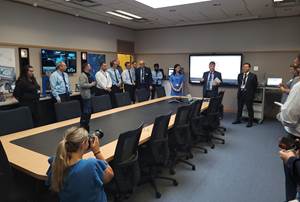6 Ways Electrification is Shifting Automotive Manufacturing
Trends to watch at IMTS: A Tier One transmission supplier weighs in on how hybrid and electric vehicles are changing the requirements for automotive component producers.
Share





The central challenge around electrification in the automotive industry is “the challenge of transformation,” says Vaden Lillard, director of operations for ZF North America’s Gray Court, South Carolina, facility. “When is electrification coming?”
Lillard runs the Tier One supplier’s Gray Court facility in South Carolina, where for 12 years it has manufactured transmissions for internal combustion engines (ICEs) ranging from passenger cars to commercial trucks. Now, the company is in a transitional moment — it is continuing to manufacture ICE transmissions while at the same time producing these systems for hybrid vehicles, and while also looking to serve the emerging electric vehicle (EV) market with products including full electric vehicle drives (EVDs) and reducer gears.
To meet all these fluctuating needs, Lillard says the facility has had to fully embrace its identity as a “Flex Plant.” Its current mix of production provides insights into some ways that vehicle manufacturing is changing in light of electrification:
Greater precision. Electromotors operate at high torque and RPM; keeping an EVD running smoothly requires tight tolerances to maintain efficiency and minimize sound and vibration, which can translate into more stringent requirements for manufactured components compared to those for ICEs.
Higher levels of cleanliness. The electronic components of EV motors require a clean environment for assembly, which means greater attention to HVAC systems and air filters, as well as enclosing spaces, to control airborne particles.
More automation. Current assembly lines at ZF are about 33% automated; Lillard says that for the EV products, lines will be closer to 70% automated. The increase is partly due to workforce competition and the need to offset rising labor costs, but also because of the precision components involved and overall quality requirements.
Increased digitization. ZF has a team of four employees dedicated to digitization and is implementing efforts related to plant management and equipment maintenance. Adding new equipment to serve hybrid and electric vehicles has presented the opportunity to create digital twins of these machines, which will help in future planning.
3D printing to support “speed of change.” ZF relies on 3D printing for items such as robot tooling, but also finds this technology valuable for producing part stand-ins. As the manufacturing floor is reconfigured based on changing demand, 3D printed prototypes can be used to set up and test machines before the real parts arrive, saving time in this changeover.
Adaptability. The Gray Court facility currently manufactures eight- and nine-speed ICE transmissions and reducer gears for EVs; within the next few years it will add production of plug-in hybrid transmissions and full EVDs. It’s a lot to balance under one roof, especially as any changes to the floorplan have to be accomplished without disrupting ongoing production. But staying flexible will serve the plant well up to and through electrification.
“We wanted to leave ourselves available,” Lillard says regarding the setup of the facility. “We’ve put ourselves into a position that we’re ready for what the market asks for.”
About the Author
Stephanie Hendrixson
Stephanie Hendrixson reports on 3D printing technology and applications as executive editor for . She is also co-host of , a video series that highlights unique, unusual and weird 3D printed parts, and co-host and creator of the .
Related Content
The Best of IMTS24 In Photos (We Saved the Best One for Last!)
From quadruped robot dogs, to an in-booth putting green where you can test out a new golf putter, to a 3D-printed car and more, attendees enjoyed cutting-edge technology and innovations all week long. Take a look to see what (or who!) you might have missed this week!
Read MoreMarposs Celebrates its Past, Eyes Future Opportunities
During its open house in Auburn Hills, Michigan, Marposs presentations focused on future opportunities across growing industries such as EV and semiconductors.
Read MoreSchwanog Custom Form Tools Reduce Cycle Times
IMTS 2024: Schwanog’s insertable form tool system supports the manufacture of precision parts for industries such as medical, automotive, aerospace and others.
Read MoreFaster Programming and Training Helps Automotive Shop Thrive
Features that save on training, programming and cycle times have enabled Speedway Motors to rapidly grow and mature its manufacturing arm.
Read MoreRead Next
Last Chance! 2025 Top Shops Benchmarking Survey Still Open Through April 30
Don’t miss out! 91ÊÓƵÍøÕ¾ÎÛ's Top Shops Benchmarking Survey is still open — but not for long. This is your last chance to a receive free, customized benchmarking report that includes actionable feedback across several shopfloor and business metrics.
Read MoreAMRs Are Moving Into Manufacturing: Considerations for Implementation
AMRs can provide a flexible, easy-to-use automation platform so long as manufacturers choose a suitable task and prepare their facilities.
Read MoreMachine Shop MBA
Making Chips and 91ÊÓƵÍøÕ¾ÎÛ are teaming up for a new podcast series called Machine Shop MBA—designed to help manufacturers measure their success against the industry’s best. Through the lens of the Top Shops benchmarking program, the series explores the KPIs that set high-performing shops apart, from machine utilization and first-pass yield to employee engagement and revenue per employee.
Read More.jpg;width=70;height=70;mode=crop)
















.jpg)








